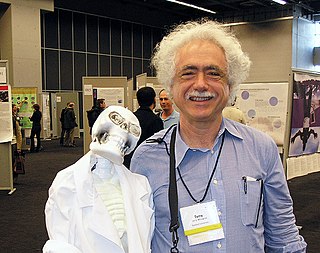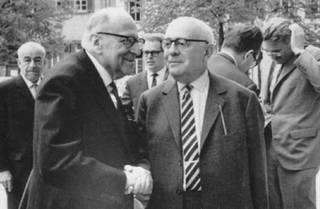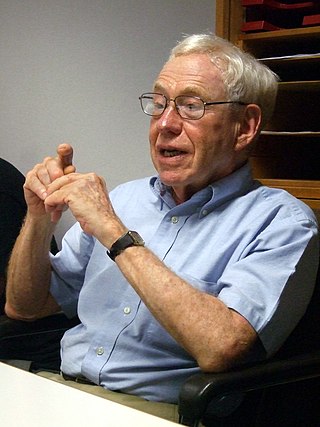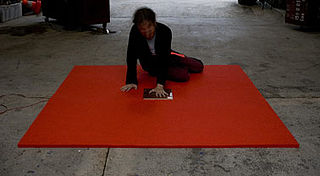Related Research Articles

Posthumanism or post-humanism is an idea in continental philosophy and critical theory responding to the presence of anthropocentrism in 21st-century thought. Posthumanization comprises "those processes by which a society comes to include members other than 'natural' biological human beings who, in one way or another, contribute to the structures, dynamics, or meaning of the society."

Terry Allen Winograd is an American computer scientist. He is a professor at Stanford University, and co-director of the Stanford Human–Computer Interaction Group. He is known within the philosophy of mind and artificial intelligence fields for his work on natural language using the SHRDLU program.

The Frankfurt School is a school of thought in sociology and critical philosophy. It is associated with the Institute for Social Research founded at Goethe University Frankfurt in 1923. Formed during the Weimar Republic during the European interwar period, the first generation of the Frankfurt School was composed of intellectuals, academics, and political dissidents dissatisfied with the socio-economic systems of the 1930s: namely, capitalism, fascism, and communism. Significant figures associated with the school include Max Horkheimer, Theodor Adorno, Walter Benjamin, Wilhelm Reich, Herbert Marcuse, and Jürgen Habermas.
New media are communication technologies that enable or enhance interaction between users as well as interaction between users and content. In the middle of the 1990s, the phrase "new media" became widely used as part of a sales pitch for the influx of interactive CD-ROMs for entertainment and education. The new media technologies, sometimes known as Web 2.0, include a wide range of web-related communication tools such as blogs, wikis, online social networking, virtual worlds, and other social media platforms.

Electronic art is a form of art that makes use of electronic media. More broadly, it refers to technology and/or electronic media. It is related to information art, new media art, video art, digital art, interactive art, internet art, and electronic music. It is considered an outgrowth of conceptual art and systems art.

Being and Time is the 1927 magnum opus of German philosopher Martin Heidegger and a key document of existentialism. Being and Time is among the most influential texts of 20th century philosophy. It had a notable impact on subsequent philosophy, literary theory and many other fields. Though controversial, its stature in intellectual history has been compared with works by Kant and Hegel. The book attempts to revive ontology through an analysis of Dasein, or "being-in-the-world." It is also noted for an array of neologisms and complex language, as well as an extended treatment of "authenticity" as a means to grasp and confront the unique and finite possibilities of the individual.

Hubert Lederer Dreyfus was an American philosopher and a professor of philosophy at the University of California, Berkeley. His main interests included phenomenology, existentialism and the philosophy of both psychology and literature, as well as the philosophical implications of artificial intelligence. He was widely known for his exegesis of Martin Heidegger, which critics labeled "Dreydegger".
Robin Tolmach Lakoff is a professor emerita of linguistics at the University of California, Berkeley. Her 1975 book Language and Woman's Place is often credited for making language and gender a major debate in linguistics and other disciplines.

Paul Dourish is a computer scientist best known for his work and research at the intersection of computer science and social science. Born in Scotland, he holds the Steckler Endowed Chair of Information and Computer Science at the University of California, Irvine, where he joined the faculty in 2000, and where he directs the Steckler Center for Responsible, Ethical, and Accessible Technology. He is a Fellow of the AAAS, the ACM, and the BCS, and is a two-time winner of the ACM CSCW "Lasting Impact" award, in 2016 and 2021.

Andrew Feenberg is an American philosopher. He holds the Canada Research Chair in the Philosophy of Technology in the School of Communication at Simon Fraser University in Vancouver. His main interests are philosophy of technology, continental philosophy, critique of technology and science and technology studies.

Virtual art is a term for the virtualization of art, made with the technical media developed at the end of the 1980s. These include human-machine interfaces such as visualization casks, stereoscopic spectacles and screens, digital painting and sculpture, generators of three-dimensional sound, data gloves, data clothes, position sensors, tactile and power feed-back systems, etc. As virtual art covers such a wide array of mediums it is a catch-all term for specific focuses within it. Much contemporary art has become, in Frank Popper's terms, virtualized.
Richard Coyne is a professor at the University of Edinburgh and author of several books on the implications of information technology and design, published by MIT Press, Routledge, and Bloomsbury Academic. His work is strongly influenced by the writings of the philosopher Hans-Georg Gadamer on hermeneutics and interpretation theory, particularly as developed by Coyne's colleague Adrian Snodgrass in the 1990s, and with whom he co-authored the book Interpretation in Architecture: Design as a Way of Thinking.
Technoromanticism: Digital Narrative, Holism, and the Romance of the Real is a philosophical book written by Richard Coyne, published in 1999.

Internet art is a form of new media art distributed via the Internet. This form of art circumvents the traditional dominance of the physical gallery and museum system. In many cases, the viewer is drawn into some kind of interaction with the work of art. Artists working in this manner are sometimes referred to as net artists.

Maurizio Bolognini is a post-conceptual media artist. His installations are mainly concerned with the aesthetics of machines, and are based on the minimal and abstract activation of technological processes that are beyond the artist's control, at the intersection of generative art, public art and e-democracy.
Mario Costa was an Italian philosopher. He was known for his studies of the consequences of new technology in art and aesthetics, which introduced a new theoretical perspective through concepts such as the "communication aesthetics", the "technological sublime", the "communication block", and the "aesthetics of flux".

New media art includes artworks designed and produced by means of electronic media technologies. It comprises virtual art, computer graphics, computer animation, digital art, interactive art, sound art, Internet art, video games, robotics, 3D printing, immersive installation and cyborg art. The term defines itself by the thereby created artwork, which differentiates itself from that deriving from conventional visual arts such as architecture, painting or sculpture.
Digital Performance refers to the use of computers as an interface between a creator, consumer of images, and sounds in a wide range of artistic applications. It is performance that incorporates and integrates computer technologies and techniques. Performers can incorporate multimedia into any type of production whether it is live on a theatre stage, or in the street. Anything as small as video recordings or a visual image classifies the production as multimedia. When the key role in a performance is the technologies, it is considered a digital performance. This can be as simple as making projections on a screen for a live audience or as complex as planning and putting on a show online.

Stéphan Barron is a contemporary artist. He developed through his artworks since the 1980s the ideas of Planetary Art and Technoromanticism. Planetary Art is an art form which takes the Earth in its planetary dimension as its basis for artistic creation. Technoromanticism is the theory of links between art and new technologies, within the context of the threats posed to Nature by technoscience and economic development. Technoromanticism also seeks to analyse the return of the human body within technological arts, formulating the hypothesis that a technological society needs a corporeal rebalancing of perceptions.

Hegel's Ontology and the Theory of Historicity is a 1932 book about the philosopher Georg Wilhelm Friedrich Hegel and his theory of historicity by the philosopher Herbert Marcuse. It is influenced by the philosopher Martin Heidegger.
References
- ↑ Furst, L. R. 1969. Romanticism in Perspective: A Comparative Study of Aspects of the Romantic Movements in England, France and Germany. London: MacMillan.
- ↑ Coyne, Richard. 1999. Technoromanticism: Digital Narrative, Holism, and the Romance of the Real. Cambridge, Massachusetts: MIT Press
- ↑ The term "Technoromantisme" is quoted several times in Barron's doctaral thesis "Art planétaire et Romantisme Techno-écologique", Université Paris VIII, 1997 http://www.technoromanticism.com/theorie/TEXTES_THESE_HDR/these.html
- ↑ Technoromantisme, Ed. L’Harmattan, Paris, 2003
- ↑ Moravec, Hans P. 1988. Mind Children: The Future of Robot and Human Intelligence. Cambridge, Massachusetts: Harvard University Press.
- ↑ Wertheim, Margaret. 1999. The Pearly Gates of Cyberspace: A History of Space from Dante to the Internet. London: Virago.
- ↑ Marcuse, Herbert. 1991. One-Dimensional Man: Studies in the Ideology of Advanced Industrial Society. London: Routledge.
- ↑ Bernstein, Richard J. 1983. Beyond Objectivism and Relativism. Oxford: Basil Blackwell.
- ↑ Turkle, Sherry. 1995. Life on the Screen: Identity in the Age of the Internet. London: Weidenfeld and Nicolson.
- ↑ Lakoff, George, and Mark Johnson. 1980. Metaphors We Live By. Chicago, Ill.: University of Chicago Press.
- ↑ "What's After Post-Internet Art? | Spike Art Magazine". Spike. Retrieved 2024-09-14.
- ↑ "PIN–UP | GENEVIEVE GOFFMAN AND THE NEW TECHNOROMANTICS". PIN–UP | GENEVIEVE GOFFMAN AND THE NEW TECHNOROMANTICS. Retrieved 2024-09-14.
- ↑ ""Icarus 2.0" | Cankarjev dom". www.cd-cc.si. Retrieved 2024-09-14.
- ↑ Technoromantisme
- ↑ Winograd, Terry, and Fernando Flores. 1986. Understanding Computers and Cognition: A New Foundation for Design. Reading, Mass.: Addison Wesley.
- ↑ Clark, Andy. 1997. Being There: Putting Brain, Body and World Together Again. Cambridge, Massachusetts: MIT Press.
- ↑ Dreyfus, Hubert L. 1972. What Computers Can’t Do: The Limits of Artificial Intelligence. New York: Harper and Row.
- ↑ Coyne, Richard. 1995. Designing Information Technology in the Postmodern Age: From Method to Metaphor. Cambridge, Massachusetts: MIT Press.
- ↑ Coyne, Richard. 2005. Cornucopia Limited: Design and Dissent on the Internet. Cambridge, Massachusetts: MIT Press.